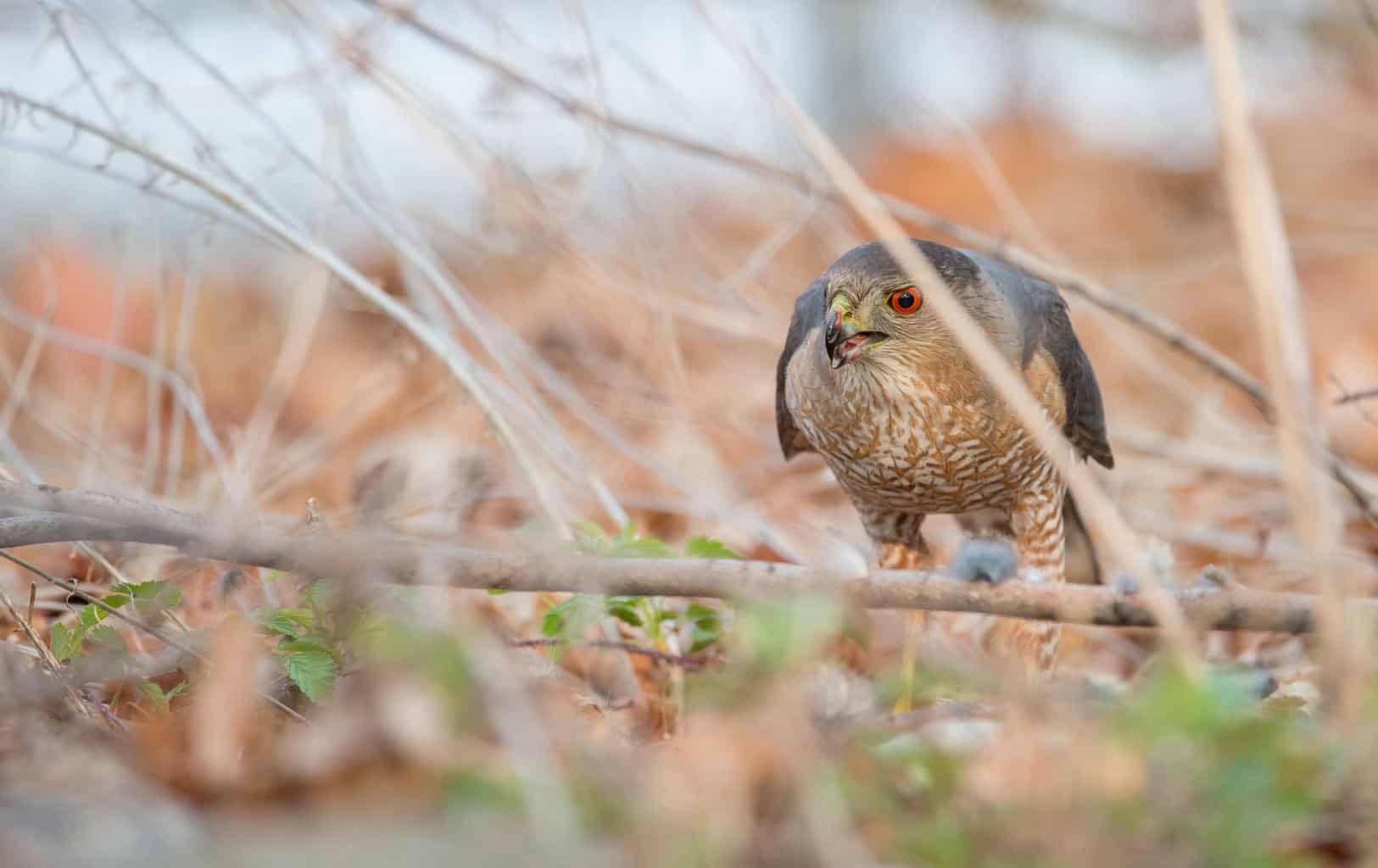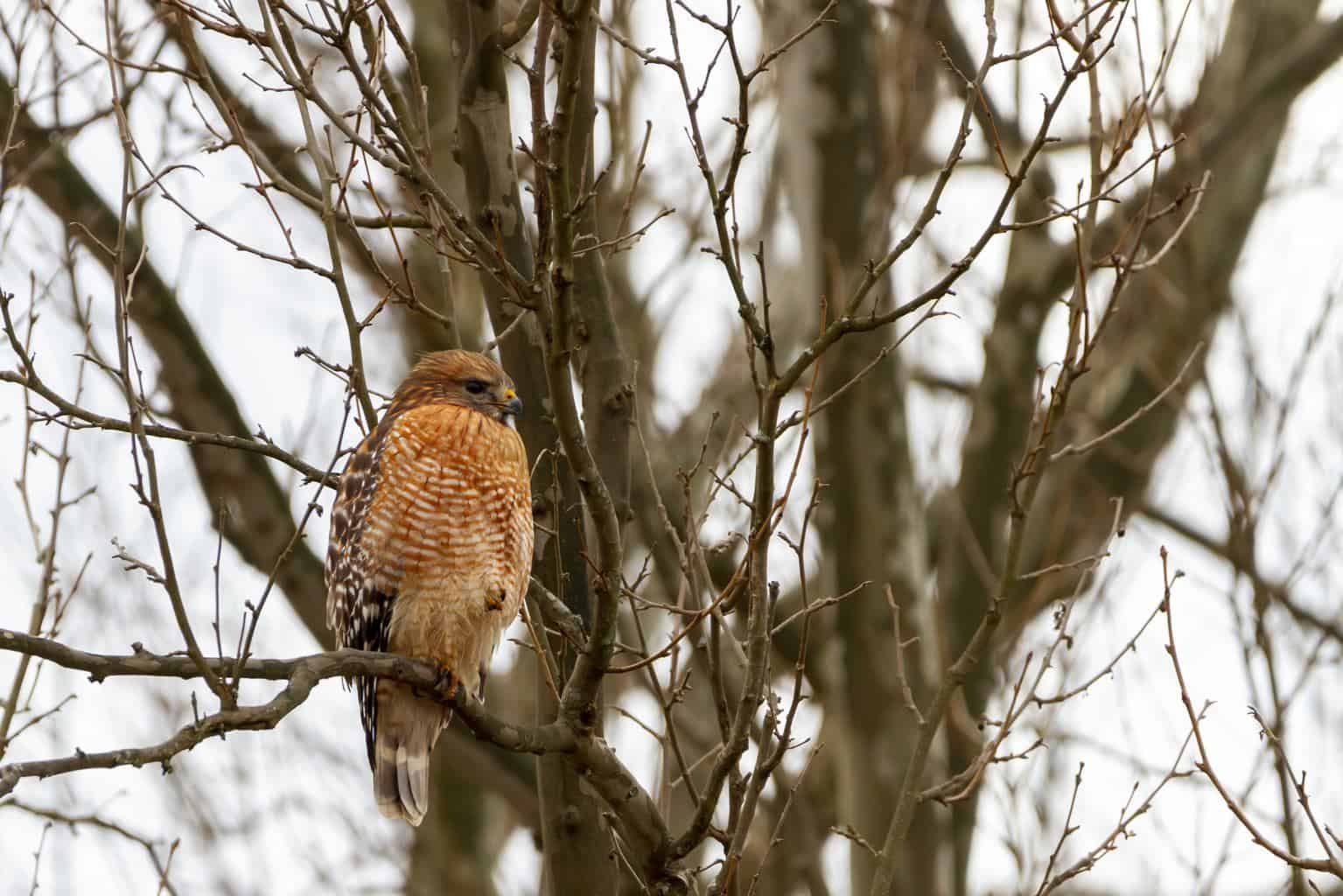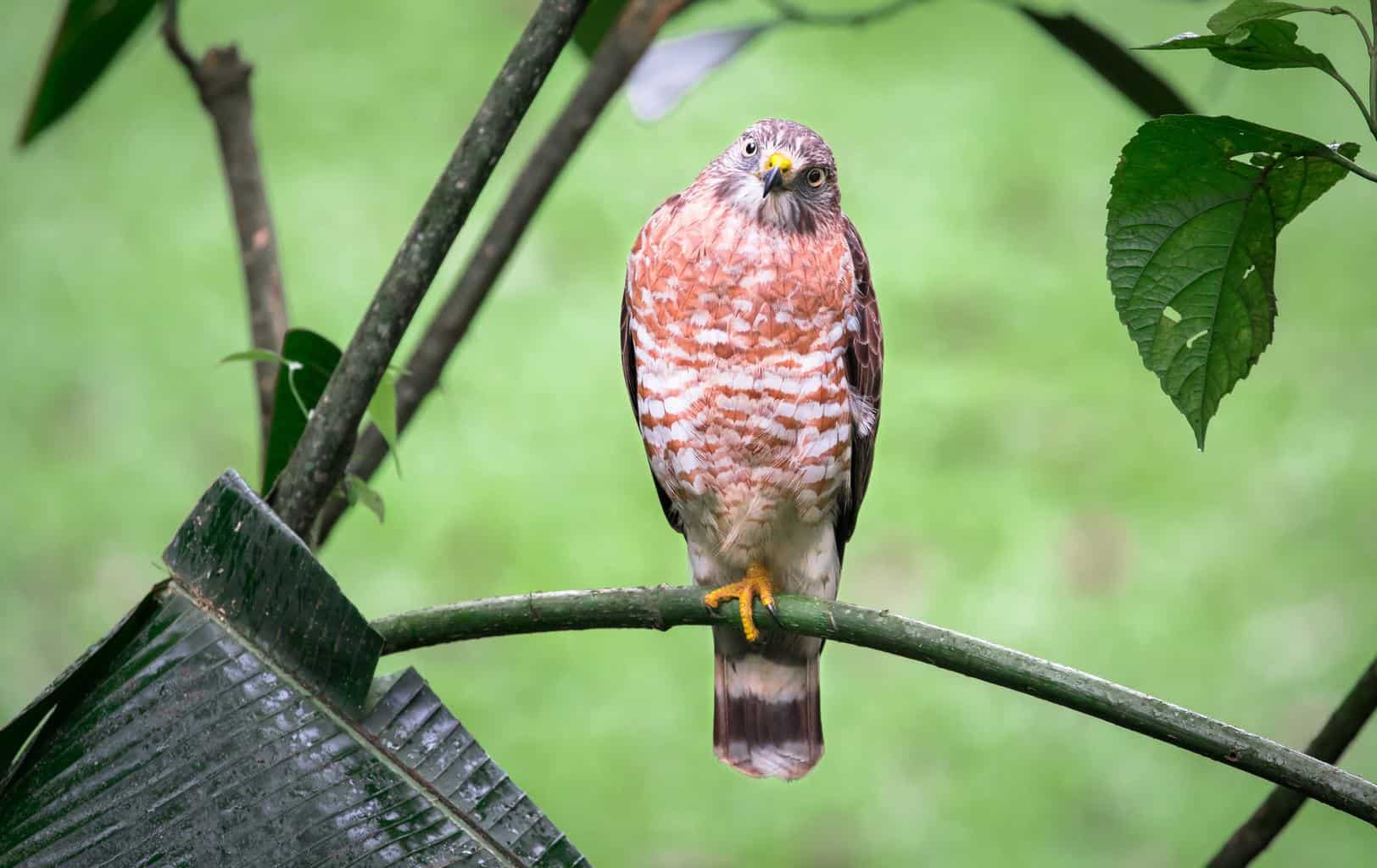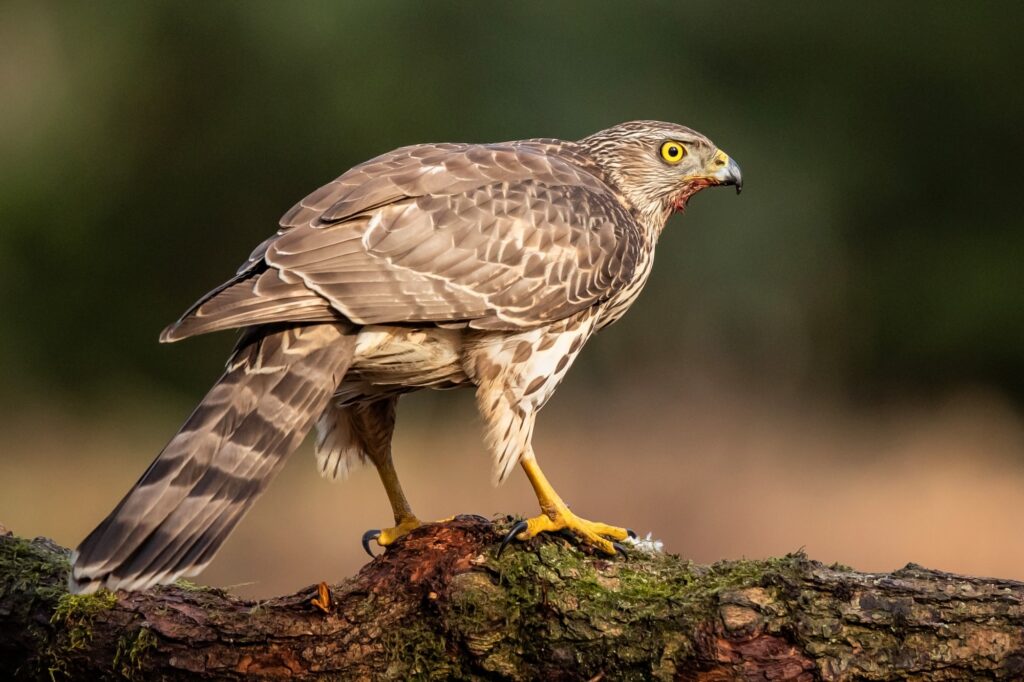Wisconsin cheese might be what brought you and other tourists to the state in the first place, but the state’s natural scenes and wildlife will no doubt keep you there. Many unique birds are Wisconsin residents, including eight species of hawks.
The midwestern state’s humid weather, along with its coastline on Lake Michigan and Lake Superior, both give the birds of prey the perfect environment to breed and live. A total of 43 parks and 23 forest areas can be found in America’s Dairyland, and if you plan an outing in one of these areas, you’ll come across birds you may not have been able to see otherwise.
In this article, we’ll show you the eight species of hawks in Wisconsin so you know exactly what to expect on your next trip!
Red-Tailed Hawk

- Scientific Name: Buteo jamaicensis
- Length: 19–25 inches
- Weight: 1.75–3.5 pounds
- Wingspan: 48–53 inches
There are around two million red-tailed hawks in North America, which is about 90 percent of the species’ numbers globally, so you’ll surely run across one of them in Wisconsin.
These hawks spend the whole year in Wisconsin, and while they breed in the northern parts of the state, some of them may fly to its southern regions in the cold months.
Red-tailed hawks mostly prey on voles, rats, rabbits, and ground squirrels, so you’re not likely to see them near a feeder, though they will occasionally make a meal of a bird or two. As the second-largest buteos, their large size helps them attack a wide range of prey.
Sharp-Shinned Hawk

- Scientific Name: Accipiter striatus
- Length: 9.5–13.5 inches
- Weight: 3–7.7 ounces
- Wingspan: 17–22 inches
Sharp-shinned hawks are the smallest accipiters in North America, which makes them the smallest in Wisconsin, too. But don’t be misled by their stature; they may be tiny, but they’re fierce hunters known for stalking bird feeders to find their next meal.
Because of their affinity for sparrow- to robin-sized birds, you’ll likely see these birds around backyard bird feeders. When not in residential areas, however, sharp-shinned hawks can be found lurking deep in the woods.
Adults of this species are blue-gray in color with reddish-orange horizontal stripes on their chest feathers. Juveniles, on the other hand, are mostly brown.
Sharp-shinned hawks migrate to Alaska and Canada in their breeding season, but they get back to Wisconsin around winter. Despite that, a lot of them spend the four ranges in Wisconsin, so they stay in it all-year-round.
Northern Goshawk

- Scientific Name: Accipiter gentilis
- Length: 20–23 inches
- Weight: 1.5–3 pounds
- Wingspan: 38–41 inches
Northern Goshawks are big birds. In fact, they’re larger than most species on this list. In addition to their size, rounded wings, long tails, and gray bodies are key identifiers for these birds.
They spend the whole year in Wisconsin, particularly the northern part of the state, and this species is a bit hard to find because they spend nearly all their time deep in wooded areas. That’s the only place to catch them, and because they’re known for attacking people who come too close to their nests, you’ll want to proceed with caution and keep your distance if you see one of them.
There are a lot of animals that northern goshawks feed on, including birds, insects, and mammals.
Cooper’s Hawk

- Scientific Name: Accipiter cooperii
- Length: 14–16 inches
- Weight: 8–12 ounces
- Wingspan: 28–30 inches
At first glance, you might think the Cooper’s and sharp-shinned hawk species are the same raptors, but take a closer look and you’ll see that, despite looking pretty much the same as far as coloration is concerned, Cooper’s hawk is a larger bird.
They spend the entirety of the year in Wisconsin, migrating to the northern part of the state when it’s time to breed. These hawks spend a lot of time in wooded areas, but when they’re not there, you’ll find them around suburban areas and in backyards.
Cooper’s hawks are known for their dangerous hunting skills. They stalk bird feeders a lot in their search for songbirds, so there’s a high chance you’ll see one up close if you put a feeder in your backyard. If you want to protect the smaller birds that frequent your yard, take down the feeder for a week or two after a Cooper’s hawk sighting. Once you’re sure the predator has moved elsewhere, you can put it back up.
Red-Shouldered Hawk

- Scientific Name: Buteo lineatus
- Length: 17–24 inches
- Weight: 17–27.3 ounces
- Wingspan: 37–43.5 inches
Much like red-tailed hawks, the red-shouldered species spends the whole year in Wisconsin, too. They breed in the northern part of the state and feed on birds, small mammals, and reptiles.
You’ll find these hawks tucked away in wooded areas, building nests and looking for prey among deciduous and mixed forests. It’s not uncommon for the red-shouldered hawk to reuse its nest year after year, so if you’ve ever spotted one of them in the past, chances are you’ll find it in the same spot again.
Despite being one of the most common species in the United States, finding a red-shouldered hawk in Wisconsin won’t be an easy feat. Because of the wooded areas’ clearing, these birds have become endangered in the state.
Broad-Winged Hawk

- Scientific Name: Buteo platypterus
- Length: 13.5–17.4 inches
- Weight: 9.3–20 ounces
- Wingspan: 32–39.5 inches
Though seeing a broad-winged hawk in Wisconsin isn’t impossible, it does prove to be difficult, as they only breed in the state. That puts them in the state around the fall or spring months, and you’re likely to see them spending time along Lake Michigan.
Now, when broad-winged hawks leave North America in the fall and head to Central and South America to spend the winter, it’s quite a sight to behold. They fly in flocks of hundreds, even thousands, called kettles as they travel along ridges and coastlines. Your best chance of catching them outside of migration, however, is straining your ears to hear their distinctive whistle.
These hawks mainly feed on other birds of prey, although their bodies are small and a bit chunky, but they’ll also eat small mammals like mice, voles, and squirrels.
Swainson’s Hawk

- Scientific Name: Buteo swainsoni
- Length: 18–23 inches
- Weight: 1.25–2.75 pounds
- Wingspan: 48–54 inches
Swainson’s hawks are often confused with red-tailed hawks because they have the same size. However, you can identify the Swainson’s hawks by the point tips of their wings or the patches of white feathers on their chins.
During breeding season from April to September, you may run across them in the western half of Wisconsin. These hawks love perching atop telephone poles, so your chances of spotting one of them are pretty high if you’ll look up. They spend their days up there to look for prey from afar so they won’t get caught.
They mostly eat small mammals and reptiles in the summertime, but in other seasons, their appetites shift and they prefer to chow down mostly on large insects.
Rough-Legged Hawk

- Scientific Name: Buteo lagopus
- Length: 19–22 inches
- Weight: 2.25–3 pounds
- Wingspan: 48–56 inches
Last but certainly not least on this list of Wisconsin hawks is the rough-legged hawk. This bird is the only species in the state to boast feathers that cover their whole bodies. Even their legs are feathered, hence the bird’s name. Thanks to that physical trait, they’re pretty easy to identify.
You may run into either a dark or light morph of the species, and your chances are better during the winter. That’s when the hawks migrate back to parts of North America after breeding in the tundra. Rough-legged hawks also keep themselves hidden when night falls, so your best bet at seeing one of these hawks is in the early morning.
Final Thoughts
If you’re headed to Wisconsin for the sole purpose of watching birds, you’ll certainly have a lot of fun. The state boasts some of the most unique birds in the United States, thanks to its wooded areas and open land. The abundance of prey birds there gives you the chance to do a lot of birdwatching during your stay, and along with the hawks we listed above, there are some awesome owls and woodpeckers you can catch a glimpse of, too!

